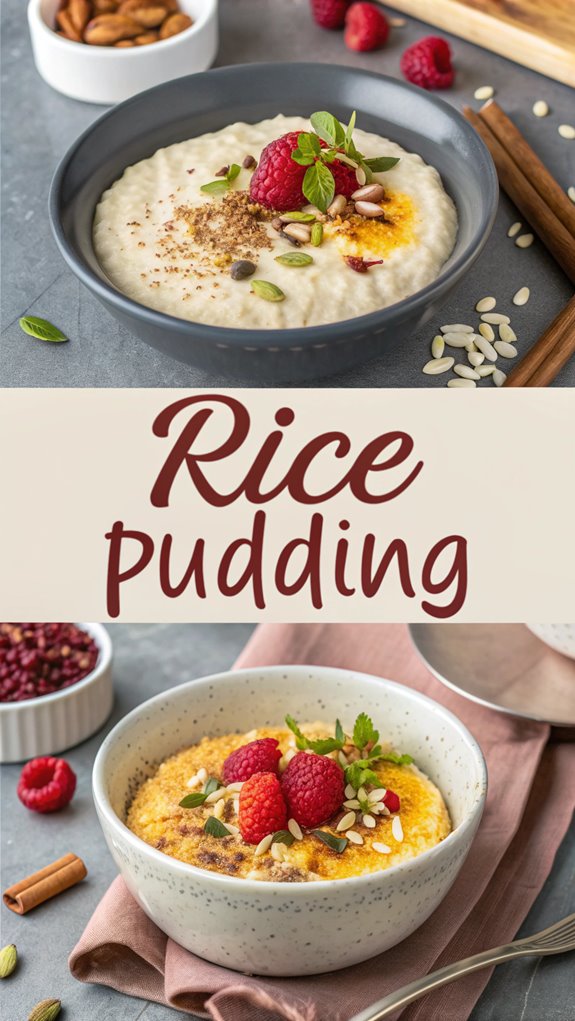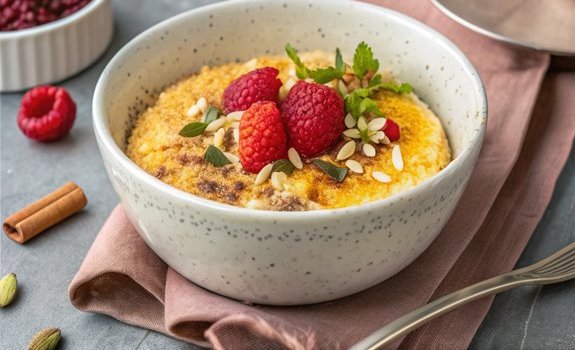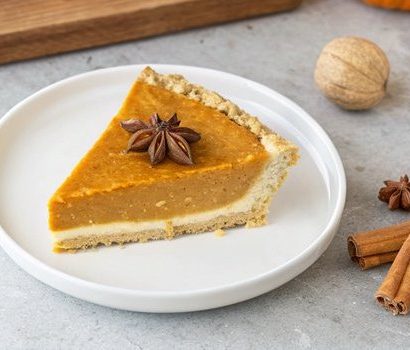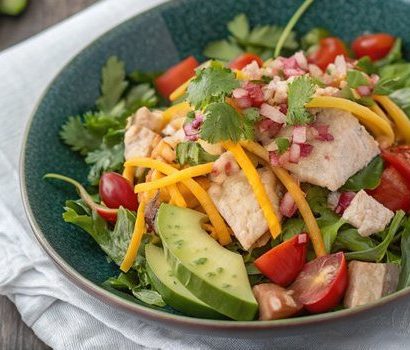Rice Pudding
Isn’t it fascinating how something as simple as rice can transform into a comforting dessert like rice pudding? You might think of it as just another sweet treat, but its rich history and cultural variations tell a much deeper story. From the creamy texture to the subtle flavors, this dish invites endless possibilities for customization. So, what makes rice pudding a beloved choice across different cuisines, and how can you elevate it in your own kitchen? Exploring these questions could lead you to unexpected culinary discoveries.
Why You’ll Love This Recipe
You’ll love this rice pudding recipe for its delightful combination of simplicity and versatility. The main ingredients—rice, milk, and sugar—are easy to find and work with, making this dish a breeze to prepare. Plus, it’s packed with vitamins B1 and B2, potassium, and magnesium, helping you stay nourished. With fewer calories than many desserts, rice pudding supports weight management while keeping you satisfied. Not only is it low in calories, but it’s also high in soluble fiber, which promotes heart health and helps reduce cholesterol levels. The complex carbohydrates provide lasting energy, making it suitable for breakfast, snacks, or dessert.
You can customize your rice pudding by adding flavors like cinnamon or nutmeg, or even fresh fruits and nuts for added texture. One of the best parts? It’s convenient. You can store leftovers in the fridge and reheat them whenever you want a quick treat. Additionally, the high starch content of the rice contributes to its creamy texture, enhancing the overall experience.
You can also adjust the portion sizes easily, making it perfect for any occasion. Whether you’re making a big batch for a family gathering or a small serving just for yourself, this rice pudding recipe is a delightful choice.
History
Rice pudding has a rich history that dates back thousands of years, with its earliest forms appearing in ancient India around 6000 BCE, where it was known as kheer. Initially, these early versions used sorghum rather than rice, reflecting the local ingredients available at the time. The dish’s popularity spread through trade routes, including the Silk Road, reaching ancient China and the Byzantine Empire.
By the 11th century, rice pudding made its way to Europe via Asian-European trade. Early European recipes were savory, often including broth, almond milk, and saffron. It wasn’t until the 15th century that the first recorded sweet rice pudding recipe emerged. During this period, rice was a luxury item, making rice pudding a dish for the elite, featuring ingredients like cream, eggs, and spices. The introduction of sweetened rice pudding marked a significant shift in its preparation and enjoyment.
The first British recipe can be found in “The Forme of Cury,” dated to the 14th century. As the 18th century approached, rice pudding became more accessible due to lower rice import costs.
Eventually, it evolved from a lavish treat to a common breakfast and dessert, celebrated today in various forms around the world.
Recipe

Rice pudding is a creamy, comforting dessert that has been enjoyed for generations. Its rich texture and warm flavors make it a perfect treat for cozy evenings or special occasions. Making rice pudding is a simple process that combines basic ingredients and a few careful steps to achieve that creamy, delicious result that everyone loves. The addition of spices and optional garnishes can elevate the dish, creating a delightful experience for the palate. This recipe features medium-grain rice to ensure optimal creaminess and starchiness.
This recipe will guide you through the process of making a classic rice pudding that’s both satisfying and easy to prepare. Whether you choose to add raisins, cinnamon, or your own twist, this dish is versatile enough to be customized to your taste. Gather your ingredients and get ready to make a dessert that will warm your heart and delight your senses.
Final Thoughts
Making rice pudding isn’t just about following a recipe; it’s a journey through history and culture that enriches the experience of this beloved dessert.
You’ll discover that this dish has ancient origins, dating back thousands of years in places like India and China. As you prepare your pudding, think about how it transformed from savory to sweet when sugar became available in the 15th century. This simple dessert can be enjoyed anytime of the day, making it a versatile choice for various occasions.
Rice pudding has many variations around the world, like kheer in India and arroz con leche in Latin America, each with unique ingredients and flavors.
This dessert isn’t just a treat; it connects to traditions and celebrations, often served at weddings and festivals.
FAQ
When it comes to rice pudding, you might’ve some questions about the best ingredients, preparation methods, or common pitfalls to avoid.
To start, use short or medium-grain rice for a creamy texture. Whole milk is essential for that rich flavor, while granulated sugar adds sweetness. Don’t forget a pinch of salt to enhance the taste, along with vanilla for added flavor.
When preparing your pudding, first cook the rice with water and salt, then mix in the milk and sugar. Keep the heat medium to low, allowing for a gentle simmer. Stir frequently to prevent sticking or burning. Cooking usually takes 30-60 minutes, so be patient. For creaminess, you can temper an egg with the hot rice mixture. Additionally, consider incorporating cultural influences to enhance the flavor profile of your rice pudding.
Common mistakes include getting the rice-to-liquid ratio wrong, which can lead to a dry or soupy pudding. Stirring too infrequently can also cause issues, as can using high heat, which may scald the milk.
Finally, be careful not to overcook the rice, as it can turn mushy. By following these tips, you’ll create a delicious rice pudding every time!



